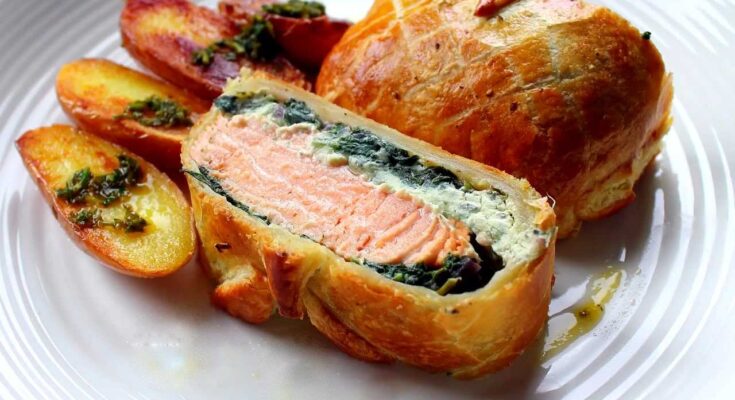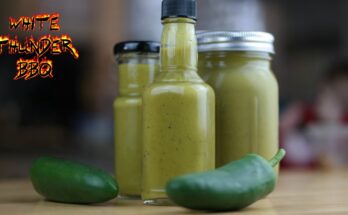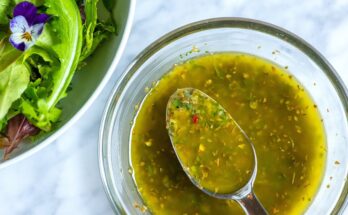Salmon Recipe: If you’ve ever wanted to make a gourmet-quality salmon dish at home, this guide is for you. Not only is salmon incredibly versatile, but it’s also brimming with heart-healthy omega-3 fatty acids, which makes it a great addition to your diet.
Whether you’re aiming for a simple, clean flavor or a rich, indulgent meal, this step-by-step recipe will help you create a perfect salmon dish, every time.
Types of Salmon
Before diving into the recipe, it’s important to choose the right kind of salmon. There are two main types to consider:
- Wild vs. Farmed Salmon: Wild salmon tends to have a richer flavor and firmer texture, while farmed salmon is typically more mild and has a softer, fattier consistency.
- Fresh vs. Frozen: Fresh salmon is ideal, but frozen salmon can be just as delicious if thawed properly. It’s more affordable and available year-round, making it a convenient option.
Ingredients Needed
Here’s a basic list of ingredients you’ll need to get started:
- Salmon Fillets (4–6 oz each)
- Olive Oil (or any cooking oil you prefer)
- Salt (to taste)
- Black Pepper (freshly ground, for best results)
Optional ingredients to enhance the flavor:
- Lemon juice
- Fresh herbs like dill, parsley, or thyme
- Garlic powder or fresh minced garlic
- Paprika or cayenne pepper for a spicy kick
Tools Required
To make this salmon dish, you’ll need:
- Baking Sheet or Skillet (depending on your cooking method)
- Aluminum Foil (if baking)
- Tongs or Spatula (for flipping the salmon)
- Meat Thermometer (optional, but helpful)
If you don’t have a specific tool, don’t worry. You can improvise with items you already have in your kitchen.
Step-by-Step Preparation Guide
1. Choosing the Right Cut of Salmon
For a quick and easy recipe, salmon fillets are your best bet. Look for fillets with the skin on for extra flavor and crispiness when cooked.
2. Thawing Frozen Salmon
If you’re working with frozen salmon, let it thaw in the fridge overnight. If you’re short on time, you can thaw it in cold water for 30–40 minutes.
3. Prepping the Salmon Fillet
Pat the salmon dry with a paper towel. Removing excess moisture helps the seasoning stick and ensures a crispy texture when cooking.
How to Season the Salmon
1. Basic Seasoning
Rub the fillet with olive oil, salt, and pepper. This simple seasoning enhances the natural flavor of the fish.
2. Other Seasoning Options
Feel free to experiment. A drizzle of lemon juice, a sprinkle of garlic powder, or fresh herbs like dill or thyme can take your salmon to the next level.
Different Cooking Methods for Salmon
There are multiple ways to cook salmon, each offering a unique flavor and texture. Let’s go over some popular methods.
Baking Salmon in the Oven
1. Temperature Settings
Preheat your oven to 400°F (200°C).
2. Cooking Time
Place the salmon on a baking sheet lined with foil. Bake for 12-15 minutes, depending on the thickness of the fillet. The fish should flake easily with a fork when done.
Pro tip: Add lemon slices on top for extra zest during baking.
Pan-Searing Salmon on the Stovetop
1. Heating the Pan
Heat a skillet over medium-high heat and add a bit of oil. When the oil shimmers, it’s ready.
2. Achieving Crispy Skin
Place the salmon fillet skin-side down in the pan. Cook for 4-6 minutes on each side, until the skin is crispy and the fish is opaque.
Grilling Salmon
1. Prepping the Grill
Make sure your grill is clean and lightly oiled to prevent sticking.
2. Tips for Outdoor Grilling
Grill the salmon for 6-8 minutes on each side over medium heat. You’ll get a slightly smoky flavor that’s perfect for outdoor dining.
Checking for Doneness
You’ll know your salmon is done when it flakes easily with a fork and has an internal temperature of 145°F (63°C). The flesh should appear opaque rather than translucent.
Serving Suggestions
Salmon pairs beautifully with a variety of side dishes. Some popular options include:
- Roasted vegetables (asparagus, broccoli, or Brussels sprouts)
- Quinoa or rice pilaf
- A fresh green salad with vinaigrette
Top your salmon with fresh herbs, lemon zest, or a drizzle of balsamic glaze for a restaurant-worthy presentation.
Storing Leftover Salmon
If you have leftovers, store them in an airtight container in the refrigerator for up to 3 days. Reheat gently in the microwave or oven to avoid drying out the fish.
Health Benefits of Salmon
Salmon is packed with omega-3 fatty acids, which are great for heart health. It’s also rich in protein, vitamins B12 and D, and selenium, making it a superfood you’ll want to include in your diet regularly.
FAQs about Salmon Recipe
Salmon is a versatile and healthy fish that can be prepared in various delicious ways. Below are some frequently asked questions about salmon recipes to help you create the perfect dish:
1. What’s the best way to cook salmon?
There are many great methods, including baking, grilling, pan-searing, and poaching. Each method brings out different flavors and textures, but the key is not to overcook the salmon to maintain its tenderness.
2. How long should I cook salmon?
Salmon typically cooks in 10-15 minutes, depending on the thickness and cooking method. An internal temperature of 145°F (63°C) ensures it’s fully cooked.
3. What seasonings go well with salmon?
Lemon, garlic, dill, and olive oil are classic choices. You can also experiment with soy sauce, honey, ginger, or spices like paprika and cumin for extra flavor.
4. Can I cook salmon from frozen?
Yes, you can cook frozen salmon. Simply extend the cooking time by 5-10 minutes depending on the method used, and ensure the internal temperature reaches 145°F.
5. What side dishes pair well with salmon?
Salmon pairs well with vegetables like asparagus, roasted potatoes, rice, or a fresh salad. The options are limitless, depending on your preferences!
Conclusion
Experimenting with flavors is key to mastering the perfect salmon dish. Don’t be afraid to try new seasonings, marinades, or cooking methods—whether you prefer a classic lemon and herb blend or something more adventurous like a spicy glaze.
Each experiment brings you closer to discovering your own signature salmon recipe. The beauty of salmon lies in its versatility, and by exploring different flavors, you’ll elevate your cooking skills and enjoy a more personalized, delicious meal every time. Embrace the process and have fun with it!



